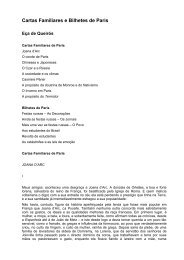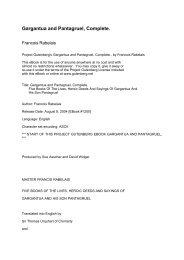The Interpretation of Dreams Sigmund Freud (1900)
The Interpretation of Dreams Sigmund Freud (1900)
The Interpretation of Dreams Sigmund Freud (1900)
You also want an ePaper? Increase the reach of your titles
YUMPU automatically turns print PDFs into web optimized ePapers that Google loves.
memories, but upon the phantasies built up on a basis <strong>of</strong> memories. <strong>The</strong> frequent occurrence <strong>of</strong> conscious day-phantasies brings these formations<br />
to our ken; but while some <strong>of</strong> these phantasies are conscious, there is a super-abundance <strong>of</strong> unconscious phantasies, which must perforce remain<br />
unconscious on account <strong>of</strong> their content and their origin in repressed material. A more thorough examination <strong>of</strong> the character <strong>of</strong> these dayphantasies<br />
shows with what good reason the same name has been given to these formations as to the products <strong>of</strong> nocturnal thought - dreams. <strong>The</strong>y<br />
have essential features in common with nocturnal dreams; indeed, the investigation <strong>of</strong> day-dreams might really have afforded the shortest and<br />
best approach to the understanding <strong>of</strong> nocturnal dreams.<br />
Like dreams, they are wish-fulfilments; like dreams, they are largely based upon the impressions <strong>of</strong> childish experiences; like dreams, they obtain<br />
a certain indulgence from the censorship in respect <strong>of</strong> their creations. If we trace their formation, we become aware how the wish-motive which<br />
has been operative in their production has taken the material <strong>of</strong> which they are built, mixed it together, rearranged it, and fitted it together into a<br />
new whole. <strong>The</strong>y bear very much the same relation to the childish memories to which they refer as many <strong>of</strong> the baroque palaces <strong>of</strong> Rome bear to<br />
the ancient ruins, whose hewn stones and columns have furnished the material for the structures built in the modern style.<br />
In the secondary elaboration <strong>of</strong> the dream-content which we have ascribed to our fourth dream-forming factor, we find once more the very same<br />
activity which is allowed to manifest itself, uninhibited by other influences, in the creation <strong>of</strong> day-dreams. We may say, without further<br />
preliminaries, that this fourth factor <strong>of</strong> ours seeks to construct something like a day-dream from the material which <strong>of</strong>fers itself. But where such a<br />
day-dream has already been constructed in the context <strong>of</strong> the dream-thoughts, this factor <strong>of</strong> the dream-work will prefer to take possession <strong>of</strong> it,<br />
and contrive that it gets into the dream-content. <strong>The</strong>re are dreams that consist merely <strong>of</strong> the repetition <strong>of</strong> a day-phantasy, which has perhaps<br />
remained unconscious - as, for instance, the boy's dream that he is riding in a war-chariot with the heroes <strong>of</strong> the Trojan war. In my Autodidasker<br />
dream the second part <strong>of</strong> the dream at least is the faithful repetition <strong>of</strong> a day-phantasy - harmless in itself - <strong>of</strong> my dealings with Pr<strong>of</strong>essor N. <strong>The</strong><br />
fact that the exciting phantasy forms only a part <strong>of</strong> the dream, or that only a part <strong>of</strong> it finds its way into the dream-content, is due to the<br />
complexity <strong>of</strong> the conditions which the dream must satisfy at its genesis. On the whole, the phantasy is treated like any other component <strong>of</strong> the<br />
latent material; but it is <strong>of</strong>ten still recognizable as a whole in the dream. In my dreams there are <strong>of</strong>ten parts which are brought into prominence by<br />
their producing a different impression from that produced by the other parts. <strong>The</strong>y seem to me to be in a state <strong>of</strong> flux, to be more coherent and at<br />
the same time more transient than other portions <strong>of</strong> the same dream. I know that these are unconscious phantasies which find their way into the<br />
context <strong>of</strong> the dream, but I have never yet succeeded in registering such a phantasy. For the rest, these phantasies, like all the other component<br />
parts <strong>of</strong> the dream-thoughts, are jumbled together, condensed, superimposed, and so on; but we find all the transitional stages, from the case in<br />
which they may constitute the dream-content, or at least the dream-facade, unaltered, to the most contrary case, in which they are represented in<br />
the dream-content by only one <strong>of</strong> their elements, or by a remote allusion to such an element. <strong>The</strong> fate <strong>of</strong> the phantasies in the dream-thoughts is<br />
obviously determined by the advantages they can <strong>of</strong>fer as against the claims <strong>of</strong> the censorship and the pressure <strong>of</strong> condensation.<br />
In my choice <strong>of</strong> examples for dream-interpretation I have, as far as possible, avoided those dreams in which unconscious phantasies play a<br />
considerable part, because the introduction <strong>of</strong> this psychic element would have necessitated an extensive discussion <strong>of</strong> the psychology <strong>of</strong><br />
unconscious thought. But even in this connection I cannot entirely avoid the phantasy, because it <strong>of</strong>ten finds its way into the dream complete, and<br />
still more <strong>of</strong>ten perceptibly glimmers through it. I might mention yet one more dream, which seems to be composed <strong>of</strong> two distinct and opposed<br />
phantasies, overlapping here and there, <strong>of</strong> which the first is superficial, while the second becomes, as it were, the interpretation <strong>of</strong> the first.[103]<br />
<strong>The</strong> dream - it is the only one <strong>of</strong> which I possess no careful notes - is roughly to this effect: <strong>The</strong> dreamer - a young unmarried man - is sitting in<br />
his favourite inn, which is seen correctly; several persons come to fetch him, among them someone who wants to arrest him. He says to his table<br />
companions, "I will pay later, I am coming back." But they cry, smiling scornfully: "We know all about that; that's what everybody says." One<br />
guest calls after him: "<strong>The</strong>re goes another one." He is then led to a small place where he finds a woman with a child in her arms. One <strong>of</strong> his<br />
escorts says: "This is Herr Muller." A commissioner or some other <strong>of</strong>ficial is running through a bundle <strong>of</strong> tickets or papers, repeating Muller,<br />
Muller, Muller. At last the commissioner asks him a question, which he answers with a "Yes." He then takes a look at the woman, and notices that<br />
she has grown a large beard.<br />
<strong>The</strong> two component parts are here easily separable. What is superficial is the phantasy <strong>of</strong> being arrested; this seems to be newly created by the<br />
dream-work. But behind it the phantasy <strong>of</strong> marriage is visible, and this material, on the other hand, has been slightly modified by the dream-work,<br />
and the features which may be common to the two phantasies appear with special distinctness, as in Galton's composite photographs. <strong>The</strong> promise<br />
<strong>of</strong> the young man, who is at present a bachelor, to return to his place at his accustomed table - the scepticism <strong>of</strong> his drinking companions, made<br />
wise by their many experiences - their calling after him: "<strong>The</strong>re goes (marries) another one" - are all features easily susceptible <strong>of</strong> the other<br />
interpretation, as is the affirmative answer given to the <strong>of</strong>ficial. Running through a bundle <strong>of</strong> papers and repeating the same name corresponds to<br />
a subordinate but easily recognized feature <strong>of</strong> the marriage ceremony - the reading aloud <strong>of</strong> the congratulatory telegrams which have arrived at<br />
irregular intervals, and which, <strong>of</strong> course, are all addressed to the same name. In the personal appearance <strong>of</strong> the bride in this dream the marriage<br />
phantasy has even got the better <strong>of</strong> the arrest phantasy which screens it. <strong>The</strong> fact that this bride finally wears a beard I can explain from<br />
information received - I had no opportunity <strong>of</strong> making an analysis. <strong>The</strong> dreamer had, on the previous day, been crossing the street with a friend<br />
who was just as hostile to marriage as himself, and had called his friend's attention to a beautiful brunette who was coming towards them. <strong>The</strong><br />
friend had remarked: "Yes, if only these women wouldn't get beards as they grow older, like their fathers."<br />
Of course, even in this dream there is no lack <strong>of</strong> elements with which the dream-distortion has done deep work. Thus, the speech, "I will pay<br />
later," may have reference to the behaviour feared on the part <strong>of</strong> the father-in-law in the matter <strong>of</strong> a dowry. Obviously all sorts <strong>of</strong> misgivings are









